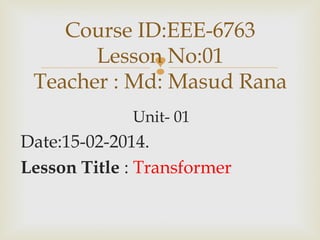Report
Share

Recommended
More Related Content
What's hot
What's hot (20)
What is Transformer, Introduction to Transformers (Brief) 

What is Transformer, Introduction to Transformers (Brief)
Lec 8 hysteresis-_eddy_current_losses_in_transformer

Lec 8 hysteresis-_eddy_current_losses_in_transformer
Similar to Transformer
Similar to Transformer (20)
Internship report report on harmonic analysis of transformer, internship repo...

Internship report report on harmonic analysis of transformer, internship repo...
Five Devices and Jobs related to Electrical and Electronics Engineering

Five Devices and Jobs related to Electrical and Electronics Engineering
Recently uploaded
Recently uploaded (20)
DC MACHINE-Motoring and generation, Armature circuit equation

DC MACHINE-Motoring and generation, Armature circuit equation
XXXXXXXXXXXXXXXXXXXXXXXXXXXXXXXXXXXXXXXXXXXXXXXXXXXX

XXXXXXXXXXXXXXXXXXXXXXXXXXXXXXXXXXXXXXXXXXXXXXXXXXXX
HOA1&2 - Module 3 - PREHISTORCI ARCHITECTURE OF KERALA.pptx

HOA1&2 - Module 3 - PREHISTORCI ARCHITECTURE OF KERALA.pptx
Bhubaneswar🌹Call Girls Bhubaneswar ❤Komal 9777949614 💟 Full Trusted CALL GIRL...

Bhubaneswar🌹Call Girls Bhubaneswar ❤Komal 9777949614 💟 Full Trusted CALL GIRL...
Standard vs Custom Battery Packs - Decoding the Power Play

Standard vs Custom Battery Packs - Decoding the Power Play
HAND TOOLS USED AT ELECTRONICS WORK PRESENTED BY KOUSTAV SARKAR

HAND TOOLS USED AT ELECTRONICS WORK PRESENTED BY KOUSTAV SARKAR
Double Revolving field theory-how the rotor develops torque

Double Revolving field theory-how the rotor develops torque
Kuwait City MTP kit ((+919101817206)) Buy Abortion Pills Kuwait

Kuwait City MTP kit ((+919101817206)) Buy Abortion Pills Kuwait
Transformer
- 1. Unit- 01 Date:15-02-2014. Lesson Title : Transformer Course ID:EEE-6763 Lesson No:01 Teacher : Md: Masud Rana
- 2. After finishing this class student will be able to understand the transformer and its working principle. General Objective:
- 3. At the end of this class students will be able to: Define the transformer Classification of the transformer Describe a practical transformer Describe a transformer is constructed and its work Explain a step-up transformer work Explain a step-down transformer work Specific Objective
- 4. Transformer is a static device which transforms electrical energy from one circuit to another circuit without any direct electrical connection with the help of Electromagnetic induction between two windings. Transformer
- 6. This transformer has two winding primary and secondary. Primary winding connected with AC source and secondary winding connected with load . Working principle of transformer
- 7. When we connect AC source in primary side circulating current create magnetic flux. This flux goes through this secondary coil and induced mutual voltage according to Faraday’s electromagnetic induction laws . Then current goes through the load . Hence electrical energy transfer one circuit to another circuit with electromagnetic induction . Working principle of transformer
- 8. There are many kind of transformer such as According to working principle: 1.Step up transformer 2.Step down transformer According to phase: 1.Single phase transformer 2.Poly phase transformer Classification of transformer
- 9. 1. Core type transformer 2. Shell type transformer 3. Spiral core type transformer According to structure:
- 10. Structure: Step up and down transformer
- 11. 1. Transmission line 2. Distribution line 3. Television 4. Computer 5. Radio 6. Telephone set 7. Welding purpose 8. Air conditioner etc Application of transformer
- 12. Transformer is most important device for transmission and distribution and other sectors. So we cannot think high and low voltage transmission and distribution without transformer. Summary
- 13. 1. What is transformer ? 2. Where are transformer used ? 3. How many transformer according to phage? 4. What is the working principle of transformer? Evaluation
